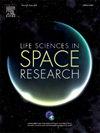非dna辐射敏感的目标,在暴露于太空辐射的大鼠中引发持续的行为缺陷
IF 2.8
3区 生物学
Q2 ASTRONOMY & ASTROPHYSICS
引用次数: 0
摘要
预测宇航员在深空任务中未来中枢神经系统的风险,将在很大程度上依赖于与空间相关的离子和行为的地面啮齿动物数据。对于大鼠来说,积累的证据表明,较低密度电离辐射,如4He和12C离子,在较低剂量下比密集电离离子,如48Ti和56Fe,诱导行为缺陷。然而,这一观察结果与标准的体细胞放射生物学相冲突,在标准的体细胞放射生物学中,密集电离离子通常比低密度电离离子更有效,并且DNA/细胞核是辐射诱导的肿瘤发生、细胞遗传畸变、基因突变和生殖细胞死亡的公认目标。为了更深入地了解辐射目标对行为风险的亚细胞性质,我们使用现有数据集比较了4He和56Fe粒子的剂量、影响和线性能量转移(LET)对大鼠四种不同行为结果的影响:升高的正迷宫(epm -焦虑)、新物体识别(nor -记忆)、操作反应(or -对环境刺激的反应)和注意力集转移(atset -认知灵活性)。我们证实,电离密度较低的粒子(质子除外)在行为缺陷方面的阈值剂量比电离密度较低的粒子低100倍(4He为0.1-1 cGy, 56Fe为15-100 cGy)。然而,当通过影响分析时,行为反应趋同,表明4He和56Fe在每轨基础上同样有效。当通过LET分析时,对于行为缺陷和DNA终点的最大有效性,LET存在~ 100倍的差异(分别为~ 1和~ 100 keV/μm)。辐射引起的行为缺陷的这些独特特征(对1 keV/μm范围内的粒子高度敏感,对0.2 keV/μm范围内的质子不敏感,以及对LET>;1 keV/μm的粒子的等流依赖)为支持一种新的假设提供了证据,即亚微米尺寸的辐射敏感靶标的行为效应与质膜和/或小于整个突触的小亚细胞结构的厚度一致。就像我们的行为发现一样,小鼠未成熟卵母细胞的杀伤,已知有一个质膜靶标,也可以更好地用影响来解释,而不是剂量。相反,对体细胞中DNA/核端点(如肿瘤诱导、染色体畸变)的影响度分析显示了相反的结果,这表明行为目标不是DNA。我们的发现提出了关于亚细胞靶点的身份和行为风险的多细胞功能单位,低剂量易感性,以及从大鼠到其他物种和宇航员的普遍性的问题。本文章由计算机程序翻译,如有差异,请以英文原文为准。
Non-DNA radiosensitive targets that initiate persistent behavioral deficits in rats exposed to space radiation
Predicting future CNS risks for astronauts during deep-space missions will rely substantially on ground-based rodent data with space-relevant ions and behaviors. For rats, the accumulated evidence indicates that less densely ionizing radiation, such as 4He and 12C ions, induce behavior deficits at lower doses than densely ionizing ions, such as 48Ti and 56Fe. However, this observation conflicts with standard somatic radiobiology, in which densely ionizing ions are generally more effective than less densely ionizing ions, and where the DNA/nucleus is the accepted target for radiation-induced tumorigenesis, cytogenetic aberrations, genetic mutations, and reproductive cell death. To gain deeper insight into the subcellular nature of the radiation targets for behavior risks, we compared the effects of dose, fluence, and linear energy transfer (LET) of 4He and 56Fe particles using existing datasets for four distinct behavioral outcomes in rats: elevated plus maze (EPM-anxiety), novel object recognition (NOR-memory), operant responding (OR-response to environmental stimuli), and attentional set-shifting (ATSET-cognitive flexibility). We confirmed that less densely ionizing particles (except protons) showed ∼100-fold lower threshold doses than densely ionizing particles for behavioral deficits (0.1–1 cGy for 4He vs. 15–100 cGy for 56Fe). However, when analyzed by fluence the behavioral responses converged, indicating that 4He and 56Fe were equally effective on a per-track basis. When analyzed by LET, there were ∼100-fold differences in the LET for maximum effectiveness for behavioral deficits and DNA endpoints (∼1 vs ∼100 keV/μm, respectively). These unique features of radiation-induced behavioral deficits (high sensitivity to particles in the 1-keV/μm range, insensitivity to protons in the 0.2 keV/μm range, and isofluence dependence for particles with LET>1 keV/μm) provide evidence in support of a new hypothesis of sub-micron sized radiosensitive targets for behavioral effects consistent with the thickness of plasma membranes and/or small subcellular structures, smaller than a whole synapse. Like our behavior findings, mouse immature oocyte killing which is known to have a plasma membrane target was also better explained by fluence, rather than dose. In contrast, fluence analyses for DNA/nuclear endpoints in somatic cells (e.g., tumor induction, chromosome aberrations) showed opposite results, suggesting that behavior targets are not DNA. Our findings raise questions regarding the identity of subcellular targets and the multi-cellular functional unit for behavior risks, low-dose susceptibility, and generalizability from rat to other species and astronauts.
求助全文
通过发布文献求助,成功后即可免费获取论文全文。
去求助
来源期刊

Life Sciences in Space Research
Agricultural and Biological Sciences-Agricultural and Biological Sciences (miscellaneous)
CiteScore
5.30
自引率
8.00%
发文量
69
期刊介绍:
Life Sciences in Space Research publishes high quality original research and review articles in areas previously covered by the Life Sciences section of COSPAR''s other society journal Advances in Space Research.
Life Sciences in Space Research features an editorial team of top scientists in the space radiation field and guarantees a fast turnaround time from submission to editorial decision.
 求助内容:
求助内容: 应助结果提醒方式:
应助结果提醒方式:


